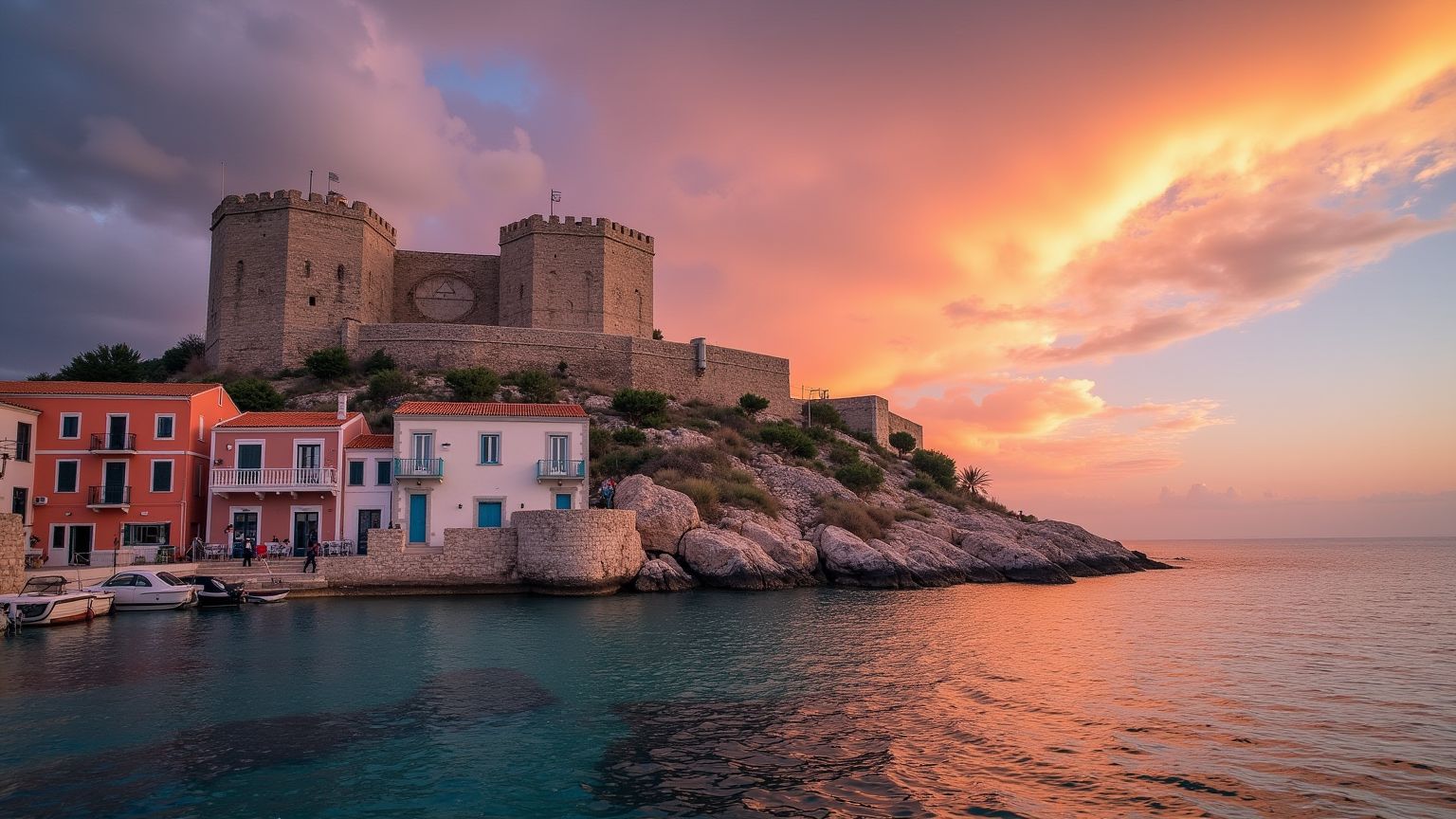Methoni Castle: A Journey Through Greece’s Medieval Marvel
Hello, I'm Kostas. After two decades of shuffling tourists through Greece's crumbling wonders, I've worn a path into the ancient stones of Methoni Castle with my own two feet. There's a moment I live for - when first-timers cross that massive stone bridge and their jaws drop at the sight of this sprawling medieval giant. No matter how many times I've done this dance, Methoni Castle still gives me goosebumps.
The Crown Jewel of the Venetian "Eyes of the Republic"

Methoni Castle isn't just another pile of old rocks - it's a medieval superstar dramatically flexing on a rocky finger that jabs into the Ionian Sea. Whenever someone asks what makes this particular fortress special (and believe me, they always do), I tell them: this wasn't some backwater outpost. This was the Mediterranean's VIP room.
The Venetians weren't subtle about its importance either. They literally called Methoni Castle and its sister fortress at Koroni "the eyes of the Republic" - fancy talk for "we're watching all you traders, so don't try anything funny." Those clever Italians needed these stone sentinels to keep their shipping lanes safe and their merchants happy.
Photos? Sure, they're nice. But they're like trying to capture the Grand Canyon with a disposable camera. You need to feel how those massive walls rise straight from the churning sea on three sides, creating what amounts to a medieval island fortress that practically screamed "don't even think about it" to would-be attackers.
A History Written in Stone: From Ancient Origins to Modern Times
"So how old is this place anyway?" - I get this question roughly seventeen times a day. While most of what you're gawking at is Venetian handiwork, Methoni Castle's story goes way back. Archaeological digging shows this spot was already turning heads in ancient times. The historian Pausanias name-dropped it as "Mothone" way back in the 2nd century, which basically makes it Instagram-famous before Instagram.
The real glow-up happened when the Venetians moved in around 1209. These water-loving merchants turned engineers transformed Methoni Castle into the stone beast we see today, creating one of their most prized overseas possessions.
What blows visitors' minds is how this place changed hands more times than a vintage sports car:
• 📜 Byzantine Years (395-1204): Just getting started with the basics
• 🦁 First Venetian Era (1209-1500): The major construction boom - walls, gates, attitude
• ☪️ Ottoman Period (1500-1685): Added that iconic Bourtzi tower and some luxurious hammams
• 🦁 Venetian Comeback Tour (1685-1715): Patched things up, modernized the defenses
• ☪️ Ottoman Sequel (1715-1828): Final tweaks before Greek independence fighters showed up
Walking these grounds is like reading a messy history book where everyone scribbled in the margins. You'll spot Byzantine stonework, Venetian lion carvings, Ottoman arches, and even French touches from their brief stay in the early 1800s. Methoni Castle is basically Mediterranean power struggles made physical.
Exploring the Castle: A Journey Through Time
I've perfected my Methoni Castle tour over the years. Not to brag, but my route hits all the historical highlights while avoiding those midday sun traps. Let me break down what you'll see.
The Stone Bridge and Main Gate
Your Methoni Castle adventure kicks off with a showstopper - that 14th-century stone bridge stretching about 200 meters across actual seawater. Originally wooden with a movable section (medieval drawbridge, anyone?), the Ottomans later upgraded to the stone version we walk today.
As you cross, take a moment. Feel small. That's exactly what approaching sailors were supposed to feel.
The main entrance still sports a weather-beaten Lion of St. Mark carved above it - basically the Venetian equivalent of slapping a designer logo on everything. I always tell my groups to pause here and imagine the wild mix of people who passed through - spice merchants, battle-weary soldiers, religious pilgrims, maybe even a spy or two.
The Castle Interior
Once you're inside, Methoni Castle's sheer size hits you. We're talking 93 acres of medieval playground - nearly 38 hectares of surprisingly intact history. Within these walls once stood a bustling community with:
• ⛪ The Church of the Transfiguration (still impressive even in ruins)
• 🧖♀️ Ottoman baths where the elite once steamed away their troubles
• 🏛️ Administrative buildings where the actual governing happened
• 🏠 Quarters for soldiers and regular folks just trying to live their lives
• 💧 Ingenious water cisterns (medieval engineering at its finest)
• 🛍️ Market squares where gossip and goods flowed equally freely
Visit in spring and Methoni Castle transforms into something magical - wild poppies and daisies burst between ancient stones, creating this perfect clash between nature and human history. My favorite spot to linger? The massive cistern system. Those medieval engineers weren't messing around - they built water collection systems so clever they could survive months of siege without outside supplies.
The Bourtzi Tower: Methoni's Iconic Landmark
If Methoni Castle had a celebrity, it would be the Bourtzi tower - that octagonal stone structure perched on its own tiny island connected by a stone pathway. The Ottomans added this architectural exclamation point in the early 1500s, and it pulled double duty as both last-stand defense point and deeply unpleasant prison.
Walking out to the Bourtzi feels like stepping into a postcard. The Ionian Sea crashes against the stones, spraying you with salt while you wonder how on earth they built this thing without modern equipment. On clear days, you can see forever from up here, which explains why Methoni Castle was worth fighting over for centuries.
Beyond Military History: Daily Life in Medieval Methoni
While the defensive architecture of Methoni Castle drops jaws, I find visitors equally captivated by the human stories these walls contained. At its peak under Venetian rule, this wasn't just some gloomy military outpost - it was a bustling little city with thousands of residents going about their lives.
The archaeological evidence paints a picture of remarkable diversity within Methoni Castle - Venetian officials pushing papers, Greek locals running shops, Jewish merchants managing trade networks, and travelers from every corner of the known world. The fortress served as a critical rest stop for religious pilgrims heading to Jerusalem, many of whom left behind accounts describing the lively port town.
Inside these walls, daily life centered around commerce, faith, and administration. The ruins reveal distinct zones for storing valuable trade goods, housing soldiers, worshipping various gods, and sheltering civilians. Their water management systems would impress modern engineers - elaborate networks for gathering and storing every precious raindrop, essential for a community that could find itself surrounded by hostile forces for months on end.
Practical Tips for Your Visit from a Local Guide
After dragging countless sunburned tourists through Methoni Castle in all weather conditions, I've gathered some hard-earned wisdom:
Best Time to Visit
Want my honest advice? Skip high summer at Methoni Castle. Instead, aim for late May/early June or September/October. You'll enjoy pleasant temperatures, thinner crowds, and perfect lighting for those Instagram shots. Spring brings an explosion of wildflowers that transform the ruins into something magical.
For the ultimate Methoni Castle experience, time your visit for about two hours before sunset. The honey-colored stones practically glow in the late afternoon light, and watching the sun sink into the Ionian Sea from the Bourtzi tower will ruin all future sunsets for you.
What to Bring
• 👟 Proper footwear - Those ancient stones weren't designed for flip-flops
• 💧 Water bottle - The medieval cisterns are empty these days
• 🧢 Sun protection - The medieval architects weren't big on shade trees
• 📸 Camera with spare batteries - You'll take more photos than you think
• 🧥 Light jacket - That sea breeze has a bite, even in summer
Allow Enough Time
The biggest mistake first-timers make? Rushing Methoni Castle. This isn't some quick photo stop - it's a massive medieval complex that deserves proper exploration. Budget at least 2-3 hours to wander the grounds, read the informational panels, and absorb the atmosphere. History buffs and photographers often spend half a day here without getting bored.
Combining Methoni Castle With Other Local Attractions
One of Methoni Castle's secret advantages is its location amid other world-class sites. When planning tours for my groups, I often create these historical combos:
Koroni Castle
Just 30km east of Methoni Castle stands its sister fortress, Koroni. These two stone giants worked together as Venice's eyes on this strategic coastline. While more compact than mighty Methoni Castle, Koroni offers something special - a still-functioning monastery inside its walls where nuns continue centuries-old traditions.
Palace of Nestor
Drive about 40km north of Methoni Castle to discover an entirely different chapter of Greek history. The Palace of Nestor showcases remarkably preserved Mycenaean architecture from the 13th century BC. After exploring medieval life at Methoni Castle, stepping back another 2,500 years creates a mind-bending historical contrast.
Natural Attractions
The region surrounding Methoni Castle boasts some of Greece's most stunning beaches. Voidokilia Beach, with its mathematically perfect omega shape, looks like something the gods designed on a particularly inspired day. After hours of historical immersion at Methoni Castle, many visitors appreciate flopping onto the soft sand of Methoni's local beaches for a restorative swim in crystal waters.
Experience Methoni Castle with Local Experts
While wandering Methoni Castle solo certainly has its charms, joining a guided tour transforms stone walls into living history. As someone who's spent more time at Methoni Castle than my own living room, I can reveal stories these ancient stones won't tell you on their own.
Local guides like myself have obsessively studied every corner of Methoni Castle. We can point out the subtle architectural differences that reveal which sections were Venetian versus Ottoman handiwork. We know where to find the hidden defensive passages that allowed soldiers to move unseen through the fortress. We've collected the human stories that bring these ruins to life.
Whether you're a hardcore history nerd, a photography enthusiast, or just someone who appreciates spectacular settings, Methoni Castle deserves prime placement on your Greek adventure list. It remains one of the Mediterranean's most complete medieval fortifications, offering a tangible connection to centuries of fascinating human drama.
A Personal Reflection
After countless visits to Methoni Castle over decades, what keeps me coming back is something I can't quite name. Maybe it's standing on those ancient walls at sunset, feeling the same sea breeze that Venetian guards felt centuries ago, creating this strange collapse of time.
I've watched wide-eyed children race through corridors where medieval soldiers once stood guard, observed artists trying to capture the timeless views, and seen history enthusiasts moved to tears by suddenly feeling connected to the past. Methoni Castle isn't just another tourist checkbox - it's a place where history breathes.
When your travels bring you to the Peloponnese, don't cheat yourself out of experiencing this extraordinary fortress. There's something about Methoni Castle that changes people, that helps us understand our place in the long human story. And if you'd like to explore it with someone who knows where all the best photo spots are (and where to hide from tour groups), I'd be honored to be your guide to one of Greece's most magnificent treasures.








